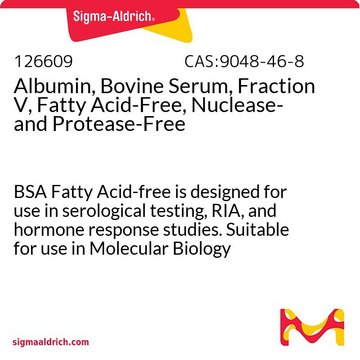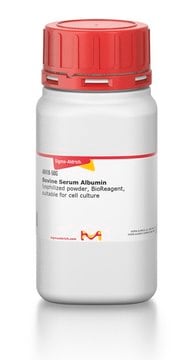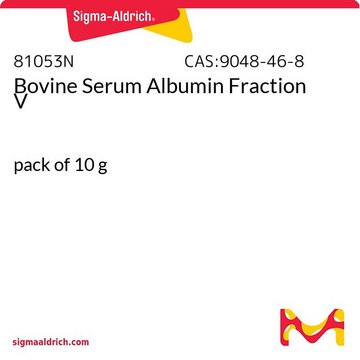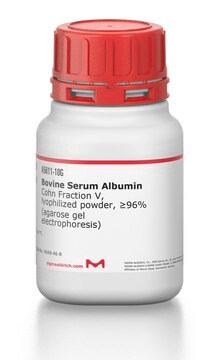03117332001
Roche
Bovine Serum Albumin Fraction V, protease-free
from bovine serum
Anmeldenzur Ansicht organisationsspezifischer und vertraglich vereinbarter Preise
Alle Fotos(1)
About This Item
UNSPSC-Code:
12352202
NACRES:
NA.21
Empfohlene Produkte
Biologische Quelle
bovine
Qualitätsniveau
Assay
≥98.5% albumin basis (electrophoresis)
Form
lyophilized
Verpackung
pkg of 50 g
Hersteller/Markenname
Roche
Methode(n)
ELISA: suitable
Versandbedingung
wet ice
Lagertemp.
2-8°C
Allgemeine Beschreibung
Bovine serum albumin (BSA) is a globular, α-helical, non-glycosylated protein is produced in the liver. It consists of three homologous, structurally different domains and two sub-domains each. BSA has 17 cysteine residues cross-linked and bound into a single chain.
Anwendung
Bovine Serum Albumin Fraction V, protease-free is used:
- for stabilization of purified enzymes
- for site-blocking reagent in ELISA techniques
- as a protein standard for determination of protein concentration
Biochem./physiol. Wirkung
Bovine Serum Albumin (BSA) facilitates the transmission of drugs, hormones, and fatty acids. It is the most commonly used blocking agent in enzyme-linked immunosorbent assay (ELISA). BSA enhances the differentiation of human embryonic stem cells (hESC) and is also a chief component of cell culture media.
Qualität
Contaminants: ≤0.001% heavy metals; proteases not detectable (casein digest)
Sonstige Hinweise
For life science research only. Not for use in diagnostic procedures.
Lagerklassenschlüssel
11 - Combustible Solids
WGK
WGK 1
Flammpunkt (°F)
Not applicable
Flammpunkt (°C)
Not applicable
Hier finden Sie alle aktuellen Versionen:
Besitzen Sie dieses Produkt bereits?
In der Dokumentenbibliothek finden Sie die Dokumentation zu den Produkten, die Sie kürzlich erworben haben.
Kunden haben sich ebenfalls angesehen
Drew C Tilley et al.
The Journal of general physiology, 151(3), 292-315 (2018-11-07)
Allosteric ligands modulate protein activity by altering the energy landscape of conformational space in ligand-protein complexes. Here we investigate how ligand binding to a K+ channel's voltage sensor allosterically modulates opening of its K+-conductive pore. The tarantula venom peptide guangxitoxin-1E
Amanda B Hummon et al.
BioTechniques, 42(4), 467-470 (2007-05-11)
A systems approach is being applied in many areas of the biological sciences, particularly in cancer research. The coordinated, simultaneous extraction of DNA, RNA, and proteins from a single sample is crucial for accurate correlations between genomic aberrations and their
Glennys V Reynoso et al.
Methods in molecular biology (Clifton, N.J.), 2023, 287-299 (2019-06-27)
This chapter provides methods for the propagation, purification, and titration of vaccinia virus (VACV) and the highly attenuated strain-modified vaccinia Ankara (MVA). Additionally, we provide information on VACV recombinants we have used for intravital imaging with multiphoton excitation.
Tamara Topală et al.
Clujul medical (1957), 87(4), 215-219 (2014-01-01)
The continuous search for new molecules with therapeutic abilities has led to the synthesis and characterization of a large number of metal complexes, proven to exhibit potential as pharmacological agents through their antibacterial, antiviral, antifungal and antineoplastic properties. As serum
Anna Lidia Wojdała et al.
Journal of Alzheimer's disease : JAD, 88(4), 1459-1468 (2022-07-06)
Phosphatidylethanolamine binding protein 1 (PEBP1) is a multifunctional protein, mainly known for its specific binding of phosphatidylethanolamine and the ability to suppress the Raf1-MAPK pathway. Its potential role as an Alzheimer's disease (AD) biomarker has been proposed in several studies.
Unser Team von Wissenschaftlern verfügt über Erfahrung in allen Forschungsbereichen einschließlich Life Science, Materialwissenschaften, chemischer Synthese, Chromatographie, Analytik und vielen mehr..
Setzen Sie sich mit dem technischen Dienst in Verbindung.








